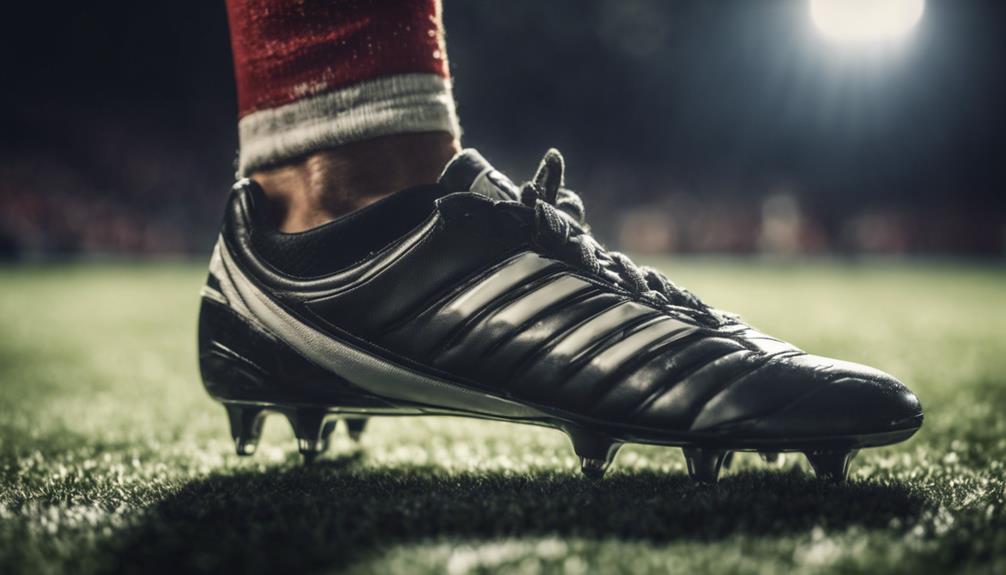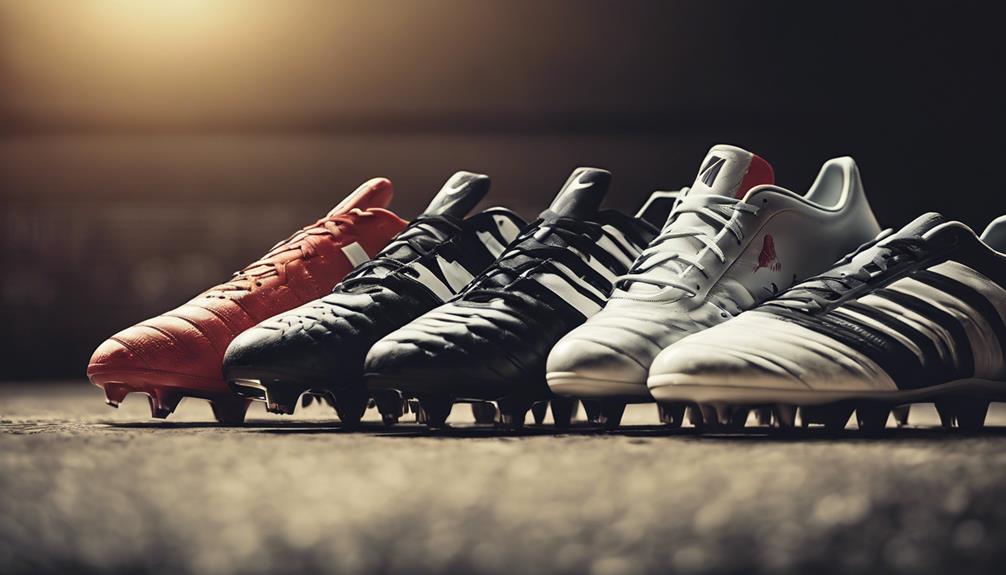How Should Soccer Cleats Fit? A Complete Guide
August 7, 2024Make sure your soccer cleats fit snugly for best performance and to avoid discomfort. Measure your foot accurately and refer to brand sizing charts for the most suitable match. Aim for a sock-like fit with space for toe movement and watch for calluses, which could indicate a subpar fit. Remember that leather cleats will mold to your foot over time, while synthetic cleats offer immediate comfort. Different brands may have varied fits, like Adidas being snug or Nike providing different fits across product lines. Proper cleat fit is vital for your agility and injury prevention.
Choosing the Right Type of Cleats
Selecting the appropriate type of cleats is crucial to enhance your performance on the field. When it comes to Soccer Cleats, choosing the right fit can make a significant difference in your game.
Ground cleats play an essential role in determining your traction and stability during play. For natural grass fields, Firm Ground Cleats are the preferred option, offering versatility and widespread usage.
Meanwhile, Soft Ground Cleats or Metal Cleats are best suited for wet, muddy fields with longer metal studs for added grip. If you find yourself playing on artificial turf, investing in New Soccer Cleats designed for turf fields will provide you with the best performance you need.
Each type of cleat caters to specific field conditions, ensuring you have the right equipment to excel in your game.
Being mindful of the ground you'll be playing on and choosing the appropriate cleats will enhance your comfort and performance on the field.
Measure Your Foot
To guarantee a proper fit for your soccer cleats, start by measuring your foot from your longest toe to your heel while standing flat on both feet. Remember to also measure the width across the ball of your foot to ascertain the cleats aren't too tight or too loose.
Once you have these measurements, compare them to a sizing chart provided by the brand to find the correct shoe size for your feet. It's crucial to take into account your personal preference for fit as well. Some players prefer a snug fit for better control and responsiveness, while others may prioritize comfort and opt for a bit more room in their cleats.
To ensure accuracy in finding the right size, consult brand-specific sizing guides, as sizes can vary between different soccer cleat manufacturers. By taking these steps, you can make sure that your soccer cleats fit you perfectly, enhancing your performance on the field.
Helpful Tips for How Should Soccer Cleats Fit

For a perfect match of your soccer cleats, prioritize achieving a snug sensation that mimics a sock-like feeling for peak performance on the field. When trying on Nike soccer cleats, make sure they fit as close to your foot as possible without causing discomfort.
It's essential to have enough space for toe retraction to prevent any pain or blisters during intense matches on grass cleats. Keep an eye out for calluses on your feet, as they can indicate an improper fit, prompting the need for a different size to enhance your overall comfort and performance.
Additionally, proper fascial tension in your cleats can greatly enhance your body control and agility during gameplay. Training your fascia can help improve the fit of your soccer cleats, ensuring better comfort and performance on the field.
Cleat Material Influence on Fit
When selecting soccer cleats, consider the material carefully as it influences how they fit your feet. Leather cleats like kangaroo leather will conform to your foot over time, while synthetic cleats offer a consistent fit from the start.
Keep in mind that sizing can vary by brand, so understanding how each material behaves is crucial to finding the best fit for your game.
Leather Cleats Stretch
Leather cleats exhibit a natural tendency to stretch with wear, adapting to your foot for a personalized fit over time. This stretching phenomenon is particularly noticeable with kangaroo leather, known for its exceptional pliability, flexibility, and comfort.
Unlike synthetic cleats that maintain their shape, leather cleats require a break-in period to mold to your feet. When selecting leather cleats, it's important to take into account this stretching feature. Initially, leather cleats should fit snugly to allow for the stretching that will occur as you wear them. This tight fit will eventually transform into a custom fit that enhances comfort and performance on the field.
If you prioritize a personalized fit and are willing to invest time in breaking in your cleats, leather options are an excellent choice. Remember, the choice between leather and synthetic cleats ultimately depends on your preference for the initial fit and long-term comfort.
Synthetic Cleats Comfort
Considering the influence of cleat material on fit, synthetic cleats offer immediate comfort due to their lack of stretching properties compared to leather options. When it comes to fit and comfort, synthetic cleats provide a more consistent feel right out of the box. Unlike leather cleats that require some break-in time to mold to your feet, synthetic cleats typically maintain their shape, offering comfort from the first wear. The lack of stretching in synthetic materials means you can expect a consistent fit throughout the lifespan of the cleats.
Opting for synthetic cleats can be a good choice if you prioritize immediate comfort and a reliable fit. These cleats are designed to offer a snug and comfortable feel without the need for a lengthy break-in period. If you value convenience and want a cleat that feels good from the get-go, synthetic options could be the way to go for your soccer footwear needs.
Sizing Varies by Brand
Brand-specific sizing varies due to the influence of cleat materials on fit. When selecting soccer cleats, keep in mind that different brands like adidas soccer, Nike, and PUMA have unique sizing and fit characteristics.
To ensure you get the right fit, consider the following:
- Adidas Soccer Cleats: Known for their snug fit, adidas cleats often run true to size. However, some models may have a narrower or wider fit, so checking the brand's sizing chart is essential.
- Nike Cleats: Nike cleats generally offer a snug fit but can vary in sizing between different product lines. It's recommended to try them on or look at specific size guides before purchasing.
- PUMA Cleats: PUMA cleats are known for their comfort and may have a more generous fit compared to other brands. Be sure to check sizing recommendations as they can differ from adidas and Nike options.
Sizing Across Soccer Cleat Brands

When comparing soccer cleat brands, variability in sizing can greatly impact the fit and comfort of your footwear. Each brand has its own unique sizing characteristics that can affect how a cleat fits your foot.
For example, adidas cleats are known to run wider but true to size in length, making them a great choice for players with wider feet looking for the best fit.
On the other hand, Nike has shifted to unisex sizing for their soccer shoes, offering a more inclusive fit that caters to a wider range of players.
PUMA cleats, in contrast, are recognized for their tight fit through the mid-foot area, providing a snug and secure feel that enhances stability on the field.
It's important to consult the specific sizing charts provided by each brand to make sure you select the right size, as sizing can vary significantly between different soccer cleat brands.
What to Do If You Ordered the Wrong Size
If you find yourself with soccer cleats that don't fit right, take advantage of free returns and exchanges.
Utilize the 30-day Wear Test Guarantee to swap sizes if needed, or consider trying a different style altogether.
Stay informed on sizing specifics for 2020 cleats and read customer reviews for insights on the best-fitting options available.
Sizing Across Cleat Brands
Consider checking the sizing charts provided by different soccer cleat brands to make sure you select the right fit and avoid the hassle of returning the wrong size.
When it comes to sizing across cleat brands:
- adidas cleats are known to be true to size for length but run wide, which can be beneficial for players with wider feet.
- Nike now offers unisex sizing for their soccer cleats, catering to a broader range of players and ensuring a more inclusive fit.
- PUMA cleats are recognized for running tight around the mid-foot area, delivering a snug and secure feel that enhances stability on the field.
Cleat Material Influence
Check the material of your soccer cleats to determine how they may influence the fit if you ordered the wrong size. Leather soccer shoes have a natural ability to stretch with wear, offering a more personalized and pliable fit over time. Kangaroo leather, in particular, is renowned for its exceptional flexibility, making it an excellent choice for players looking for a snug and custom fit.
On the other hand, synthetic soccer cleats typically don't stretch, emphasizing the importance of ensuring a comfortable fit right from the start. Additionally, various brands like adidas, Nike, and PUMA have specific sizing tendencies, so it's vital to consult their size charts for accuracy when selecting your shoe size.
If you find that you've ordered the wrong size, take advantage of the free returns and exchanges offered by many retailers to secure the perfect fit for your soccer cleats on the ground.
Return Process Guidelines
Guarantee a hassle-free return process by taking advantage of the free returns and shipping options provided for all footwear orders.
If you find that the soccer cleats you ordered don't fit quite right, follow these return process guidelines:
- Initiate the return: Contact customer service to start the return process and request a return label for your package.
- Exchange or refund: Choose whether you want to exchange the cleats for a different size or style, or opt for a refund.
- Utilize the 30-day Wear Test Guarantee: If the size is incorrect, take advantage of the 30-day Wear Test Guarantee to exchange the cleats for the right fit.
Conclusion
Remember, when it comes to how should soccer cleats fit, it's important to choose the right type, measure your foot accurately, and consider the material and sizing across brands.
Don't forget to follow these helpful tips to guarantee a comfortable and secure fit on the field.
So, next time you're shopping for cleats, keep these guidelines in mind for a perfect fit and peak performance!


